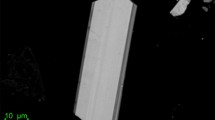Abstract
Fourier transform infrared (FTIR) measurements on thermally shocked (290<T<1100 K, t=1 and 24 h) and thermally soaked (T=803 K, 0<t<25 h) Ca-montmorillonite from Texas show that the dehydroxylation temperature for this mineral is much lower than previously reported in the literature and depends upon the thermal soak time used. The effect of thermal shock temperature on vibrational frequencies, originating from the silicate sheet, and the intensity of Al-OH-Al stretching mode suggest that Camontmorillonite dehydroxylates at 903 <T<923 K and 773<T<823 K for 1 h and 24 h thermally shocked samples, respectively. Our similar measurements on the Mn and Fe exchanged-montmorillomte from Texas demonstrate that the dehydroxylation temperature range is also affected by the type of cations present in the interlayer. The thermal soak (T=803 K, 0<t<25 h) measurement on Ca-montmorillonite indicates that the dehydroxylation of this montmorillonite proceeds via the development of intermediate structural phases. As noted by previous authors, the dehydroxylation of Mg2+ and Fe3+ octahedral sites does not affect the overall structure. However, if ∼75 percent of the hydroxyls attached to Al3+ are lost, then the lattice manifests an intermediate structural phase. In this intermediate phase, the structure of both octahedral and silicate layers is affected. On a further loss of hydroxyls (∼90% of Al3+ hydroxyls), the final montmorillonite dehydroxylate phase develops. The vibrational analysis of an isothermally treated sample suggests that the final phase is induced due to the rearrangement of the silicate oxygens, which leave the coordination around Al to be 5. The dehydroxylation results of montmorillonite (Texas) have been discussed in terms of known mechanisms, and it appears that the dehydroxylation starts at the surface and proceeds via proton delocalization at trans hydroxyl positions, followed by the protons' migration across the vacant cation sites with the formation of H2O molecules below the hexagonal holes.
Similar content being viewed by others
References
Ball MC, Taylor HFW (1961) The dehydration of brucite. Mineral Mag 32:754–766
Brindley GW, Lemaitre J (1987) Thermal, oxidation and reduction reactions of clay minerals. In: Newman ACD (ed) Chemistry of clays and clay minerals. Longman Scientific & Technical, Essex, England, pp 319–370
Buxton TS, Pollock CB (1974) The Sloss COFCAW project-further evaluation of performance during and after air injection. J Pet Technol 26:1439–1448
Farmer VC, Russell JD (1964) The infra-red spectra of layer silicates. Spectrochim Acta 20:1149–1173
Farmer VC (1974) The layer silicates. In: Farmer VC (ed) The infrared spectra of minerals. Mineralogical Soc, London, pp 331–363
Freund F (1970) Infrared spectra of Mg(OH)2 at elevated temperatures. Spectrochim Acta 26A:195–205
Freund F (1974) Ceramics and thermal transformations of minerals. In: Farmer VC (ed) The infrared spectra of minerals. Mineralogical Soc, London, pp 465–482
Grim RE (1968) Clay mineralogy (2nd ed) McGraw-Hill, New York
Grim RE, Guven N (1978) Bentonites: geology, mineralogy, properties and uses. Elsevier, Amsterdam
Heller-Kallai L, Rozenson I (1980) Dehydroxylation of dioctahedral phyllosilicates. Clays Clay Miner 28:355–368
Malhotra VM, Crelling JC (1987a) Effects of particle size and air flow rates on the runaway temperature of bituminous coal at 290<T<700 K. Am Chem Soc Preprints Fuel Div 32(4):70–81
Malhotra VM, Crelling JC (1987b) Spontaneous combustion of coal and maceral-enriched fractions under storage and pneumatic transport conditions, Annual Report, March 1986–February 1987, Department of Energy (USA), pp 1–79
Malhotra VM, Ogloza AA (1989) FTIR spectra of hydroxyls and dehydroxylation kinetics mechanism in montmorillonite. Phys Chem Minerals 16:386–393
Newman ACD, Brown G (1987) The chemical constitution of clays. In: Chemistry of clays and clay minerals. Longman Scientific & Technical, Essex, England, pp 1–128
Pampuch R (1971) Le mechanisme de la deshydroxylation des hydroxydes et des silicates phylliteux. Bull Groupe Fr Argiles 23:107–118
Parrish DR, Craig FF Jr (1969) Laboratory study of a combination of forward combustion and water flooding — the COFCAW process. J Pet Technol 21:753–761
Perry C, Gillott JE (1982) Mineralogical transformations as indicators of combustion zone temperatures during in-situ combustion. Bull Can Pet Geol 30:34–42
Prats M (1982) Thermal recovery. Monograph series Vol. 7, Soc. of Petroleum Engs., Dallas (USA) 88–109
Rozenson I, Heller-Kallai L (1980) Order-disorder phenomena accompanying the dehydroxylation of dioctahedral phyllosilicates. Clays Clay Miner 28:391–392
Russell JD, Farmer VC (1964) Infra-red spectroscopic study of the dehydration of montmorillonite and saponite. Clay Min Bull 5:443–465
Russell JD, Farmer VC, Velde B (1970) Replacement of OH by OD in layer silicates, and identification of the vibrations of these groups in infra-red spectra. Mineral Mag 37:869–879
Spiel S, Berkelheimer LH, Pask JA, Davies B (1945) Differential thermal analysis — its application to clays and other aluminous minerals, US Bur. Mines, Tech. Paper 664
Steger E (1976) The IR dichroism of muscovite absorptions <1200 cm−1. Spectrochim Acta 32A:1125–1128
Terwilliger PL (1976) Fireflooding shallow tar sands — a case history. Can J Pet Technol 15:41–48
van Olphen H, Fripiat JJ (eds) (1979) Data handbook for clay materials and other non-metallic minerals, Pergamon Press, Oxford
Vossoughi S, Willhite GP, Kritikos WP, Guvenir IM, El Shoubary Y (1982) Automation of an in-situ combustion tube and study of the effect of clay on the in-situ combustion process. Soc Pet Eng J 493–502
Wardle R, Brindley GW (1972) The crystal structure of pyrophyllite 1 Tc and its dehydroxylate. Am Mineral 57:732–739
Author information
Authors and Affiliations
Rights and permissions
About this article
Cite this article
Ogloza, A.A., Malhotra, V.M. Dehydroxylation induced structural transformations in montmorillonite: an isothermal FTIR study. Phys Chem Minerals 16, 378–385 (1989). https://doi.org/10.1007/BF00199559
Received:
Issue Date:
DOI: https://doi.org/10.1007/BF00199559




